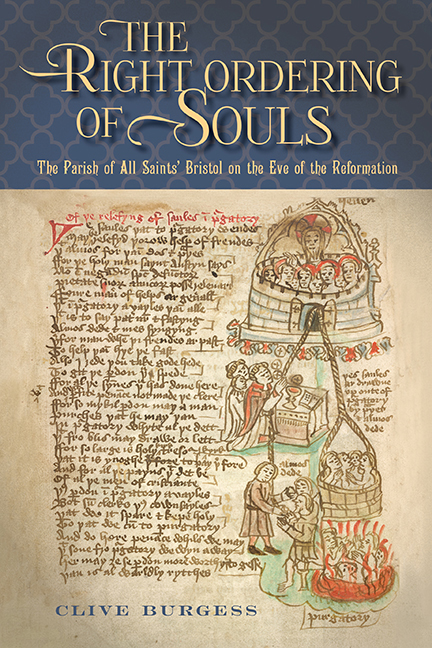Book contents
- Frontmatter
- Dedication
- Contents
- List of illustrations
- Acknowledgements
- Miscellaneous Frontmatter
- Abbreviations
- Notes
- map
- Part I For the increase of the divine service
- Part II All Saints’, Bristol, and its parishioners
- Part III Commemorating the dead
- Part IV Leaders and administrators
- 8 ‘He procured, moved and stirred’: Clergy as mentors
- 9 ‘Well willed men’: Leaders, managers and parishioners
- Coda
- Part V Ordering the parish
- Appendices
- Bibliography
- Glossary
- Index
- Miscellaneous Endmatter
Coda
from Part IV - Leaders and administrators
Published online by Cambridge University Press: 05 May 2018
- Frontmatter
- Dedication
- Contents
- List of illustrations
- Acknowledgements
- Miscellaneous Frontmatter
- Abbreviations
- Notes
- map
- Part I For the increase of the divine service
- Part II All Saints’, Bristol, and its parishioners
- Part III Commemorating the dead
- Part IV Leaders and administrators
- 8 ‘He procured, moved and stirred’: Clergy as mentors
- 9 ‘Well willed men’: Leaders, managers and parishioners
- Coda
- Part V Ordering the parish
- Appendices
- Bibliography
- Glossary
- Index
- Miscellaneous Endmatter
Summary
Safe to the use of Jhc: Speculating on the Jesus Guild
ALTHOUGH we may shed light on many aspects of parish procedure, much remains obscure. It is hard, for instance, to delineate the exact role of the masters, and harder still to compile a full roster of their achievements. To take a now-familiar example, while the masters were evidently deeply involved in the construction and management of the parish conduit in the early sixteenth century, their exact role eludes us. This only confirms a previous observation: that the most abundant parish records – the churchwardens’ accounts – reflect the lowlier routines of administration; paradoxically, we often know much less about major decisions and achievements. With this lesson in mind, we ought finally to consider materials suggesting that, in the later fifteenth century, parish leaders invested in a brotherhood further enriching the parish liturgy and invigorating parish procedures – and whose existence may, indeed, help to explain how parish managers sustained the resolve to achieve so much.
Earlier discussion has already mulled over Alice Chestre's decision, with help from her son, John, in 1477, to devise a tenement in Broad Street to the parish feoffees, so that ‘all outgoings and profits from the tenement’ – some four marks per annum – could support both a perpetual anniversary in the church and also a Mass (said, in an insert, to be ‘le salve de Jhesu’) celebrated on Fridays in the Lady aisle of All Saints’. The benefaction list notes that she did this ‘in the worship of Jesus, to the foundation of a Mass of Jesus by note to be kept and continued every Friday in this church and likewise an anthem, that [Harry and Alice] be prayed for every Friday at that Mass by name’. But the earliest, and albeit one of only a few references to a Jesus Guild in the parish, occurred in the unbound churchwardens’ accounts for 1467–68, noting that the wardens had paid the sum of 6d. ‘for mending the window in Jhc is yelde’, which, while undeniably cryptic, suggests that the guild was already extant and associated with a discrete part of the church – although quite which is not divulged.
- Type
- Chapter
- Information
- 'The Right Ordering of Souls'The Parish of All Saints’ Bristol on the Eve of the Reformation, pp. 323 - 328Publisher: Boydell & BrewerPrint publication year: 2018

